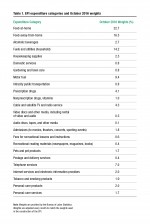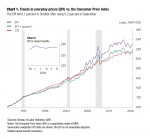Falling Agricultural Prices Clip Grocery Increases
AIER’s monthly Everyday Price Index dropped 0.1 percent in October as falling fuel and utility prices offset an increase for gasoline. The EPI measures price changes that people see in their everyday purchases, such as groceries, gasoline, utilities, and personal-care products.
The EPI including apparel, a broader measure, was unchanged in October. Over the past 12 months, both the EPI and the EPI including apparel have increased 0.4 percent. Both measures exclude prices of infrequently purchased, big-ticket items (such as cars, appliances, and furniture) and prices that are contractually fixed for prolonged periods (like housing).
The more widely known price gauge, the Consumer Price Index reported by the U.S. Bureau of Labor Statistics, increased 0.1 percent for the month on a seasonally unadjusted basis and moved 1.6 percent higher over the past 12 months. The EPI is not seasonally adjusted, so we compare it with the unadjusted CPI.
Thanksgiving is here, and for many households that means extra trips to the grocery store. Prices at groceries dropped 2.3 percent over the past 12 months, contrasting with an average annual growth rate of 2.1 percent over the past 15 years. Prices have declined across major categories, with fruits and vegetables dropping 0.8 percent over the past year and cereal and bakery products falling 1.2 percent. The EPI weights grocery store prices, so reducing the amount of cereal in a box from 24 ounces to 16 ounces would register as a price increase.
Grocery prices have been restrained by lower agricultural prices. Over the past year, the Bloomberg grain index fell 7.8 percent and the GSCI livestock index dropped 14.5 percent. The decline in livestock prices has checked meat prices. Beef prices fell 9.3 percent over the past year while turkey prices dropped 1.4 percent. Since the beginning of the year, real consumer spending on food and beverages at grocery stores has increased 3.1 percent.
A 1.9 percent decline in household fuels and utilities for October offset a 1.8 percent increase in gasoline prices. Gas prices have been supported by the shrinking supply of crude oil. Domestic crude oil production fell to 8.6 million barrels at the end of October from a peak of 9.6 million barrels a day in 2015, and in the same time frame, inventories dropped to 483 million barrels a day from 609 million barrels. This sent crude oil prices up to $43 a barrel in October from $26 a barrel at the beginning of the year.






